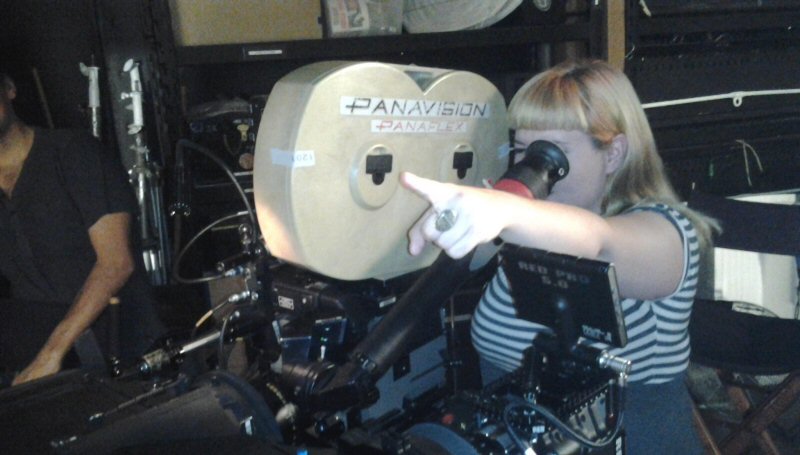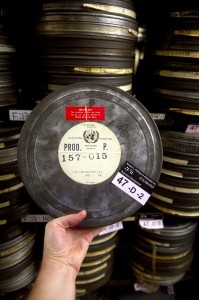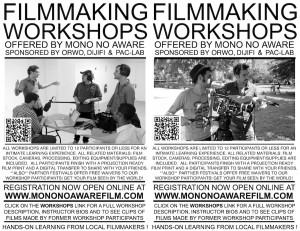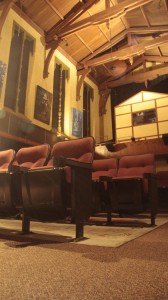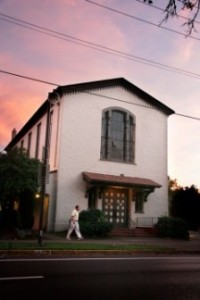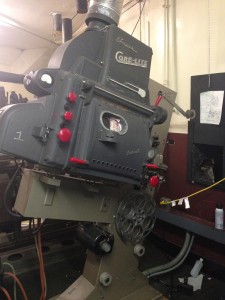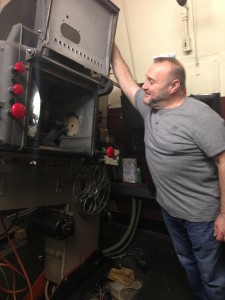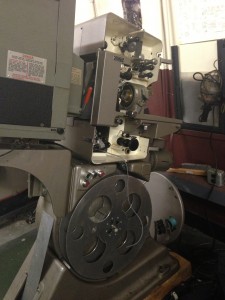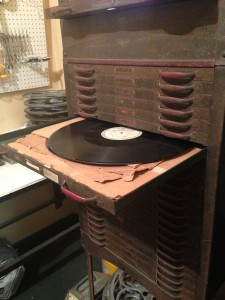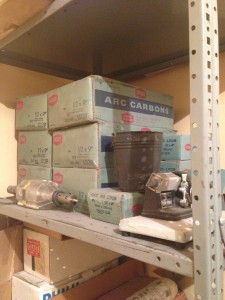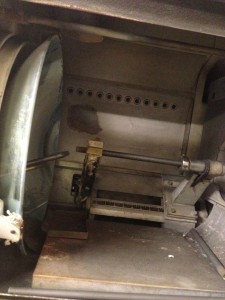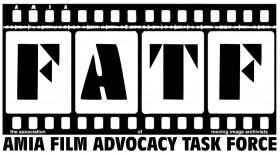In November 2011, thousands of people from around the world began to sign and share the Fight for 35mm Petition.
Seven months and 10,753 signatures later, Julia Marchese had enough support to crowdfund and produce Out of Print, an exciting documentary that presents the case for retaining the art, craft, and unique experience of 35mm motion picture presentation.
In this exclusive interview, Julia shares her passion for repertory cinema, reflects on the petition, and discusses the filming of Out of Print.
FATF: How did you become interested in film and in repertory cinema?
JM: I’ve always been a movie fan. I was a drama major, film minor in college – it was study of film, not film production – and I adored it. I moved to Los Angeles in 2001, found a New Beverly calendar and I just immediately knew that it was the place I had to work. I went there and asked for a job the first time I went, and every time I went back for five years until they finally caved and gave me a job! That was in 2006, and I’ve worked there ever since. Something about it is magic to me.
Why is repertory cinema important to you personally?
I think it’s really important to keep community of cinema alive, because if you go to a multiplex, all you do is you go in and watch a movie, and you go home and you’re not interacting with anybody.
But the New Beverly and other repertory cinemas offer an experience for people who are like-minded and want to talk about these things, and it becomes something more than just watching a film. I think that’s really important, and I think if you lose that, it’s going to be losing a really important part of cinema, which is discussion – because talking about movies is almost as fun as watching them. I think that you’re also going to be losing independently-owned places – the New Beverly is not a chain, we’re just a family-owned place. I think it’s so important to keep these places around.
Something that a lot of directors that I interviewed for Out of Print said – and I think this is really interesting – is that repertory cinemas are where they went when they were young and that’s really where they learned about film. They saw films projected in a cinema with an audience and that experience is what made them want to direct. If you take that away, what happens to the future generations of filmmakers? You could watch whatever on your computer, but that’s not going to give you the same feeling as if you saw Casablanca at a theatre surrounded by people who are oohing and aahing and crying and laughing; the group audience experience is so important to watching a film.
Can you describe the role of film projection in this?
Film projectionists are such unsung heroes, because you don’t notice them if they do their job correctly. You only notice the projectionist when the sound goes out, or the picture goes out of focus, or there’s a reel change; but if they do their job perfectly, you won’t even know they’re there. I think that’s why people are so flippant and think, “Oh well it doesn’t matter, we’ll just change to digital” – well actually there’s an artform to it, there’s people who are very, very into film and who are really careful about making sure your experience is great, and they’re getting no reward for it…and now they’re just getting fired. It’s very sad that you have this group of people who should be lauded, and they’re getting the short end of the stick. If you’ve ever been in a projection booth you’ll know that they’re running around the entire time the film’s playing – they’re making sure that everything’s OK, they’re getting the next reel ready, making sure it’s in focus – it’s a really stressful job. I think that because people don’t see them, they don’t realize how hard projectionists work.
By May 2012, 10,753 people from around the world had signed your Fight for 35mm petition. Why do you think so many people responded so passionately?
The petition started when we got a letter from one of the studios saying that in 2012 they intended to stop making new 35mm prints. That made me nervous, because I knew that eventually that would trickle down to repertory cinema. I had to stand up and say, “Hey, just to let you guys know this is happening, and we should be doing something about it”.
I think it just got the dialogue started. And because nobody had known this was even coming, it kind of came out of nowhere and blind-sided everybody. 35mm is really important; you can’t just take it away – it’s something that everybody should have a say in. I was so incredibly amazed that so many people signed it, and that it got so much press coverage, and everybody started to realize this was happening. The goal of the petition was to just get the word out, and it really did. And that’s what kind of led to Out of Print, because I realized that there are so many people out there who really care about this subject. I thought – how can I reach a broader audience? How can I really show people how important repertory cinema is? That’s why I focused on the New Beverly, but also broadened the scope to repertory cinemas in general because you should be supporting your local theatre – you’re going to really miss it if it goes.
Can you tell us about your documentary, Out of Print – how did it come about, and what were your experiences making it?
This is my first film, and honestly it could not have been a better experience. I raised the money through Kickstarter, and we raised $80,000 in 30 days. I was so amazed by the support and loyalty. I’d never dreamed that I would be able to film on 35mm, but then I got talking to Panavision, and started talking to Kodak, and told them what the film was about, and they were very, very generous and gave us a camera package, and film. Being able to shoot on 35mm was incredible, and there’s a split-screen sequence in the film where we actually show digital and 35mm side by side, because I don’t think people can know what the difference is – but then when you look at it side by side you go, “Oh OK, well I can see that now”. But filming was fantastic – I got to interview so many of my heroes – Mark Romanek, Edgar Wright, Joe Dante, Stuart Gordon, Joe Carnahan, Patton Oswalt – all these guys who I’ve looked up to, and are people who love the New Beverly, and also love film and want to fight for it. So doing that was amazing, and then getting to go and edit the film, and then do all of the sound, and all of these things – it’s been incredibly educational and really fun, and I really enjoyed the experience.
What would you like the film to accomplish?
I’m in a weird place right now because the film’s finished, and I’ve submitted it to festivals and am waiting to hear back – so I’m in that weird limbo of waiting and being on pins and needles, but I just hope that the film does well because I want it to prove to people that independent, single-screen theatres are important. And people who have watched the film so far have come out saying, “This makes me want to go to the New Beverly, and this makes me want to go to my cinema”. That makes me so happy, because that was the goal of the film – to make folks realize that they have these cultural gems in their towns that they’re probably not supporting like they should be. Single screen theatres are struggling as it is, because they’re having to compete with the multiplex and everything. So if this can drive just a little bit more business their way then I’ve done my job.
A strong theme in the film is to retain access to 35mm projection. If one were to try to curtail that, then it actually limits what you can show, among many other things.
Every time you switch to a different format you lose titles. They didn’t transfer everything from VHS to DVD, or DVD to Blu-Ray, and so everything from 35mm is certainly not going to go to digital. And so you’re going to get smaller and smaller percentages of films available to view.
Another theme is choice. Do you think people understand that they have a choice, and should have a choice, in how they experience films at the theatre, despite a prevailing narrative that clearly tries hard to persuade them otherwise?
I don’t think as many people realize they have a choice, that they can voice their preferences to their local cinema and help their local theaters keep their 35mm projectors. But that’s kind of the goal of the film – to let people know that they do, indeed, have a choice.
What’s the difference in visual information that you see with 35mm? Returning to the split-screen comparison in Out of Print – how would you describe it?
I feel that there is a depth and life to 35mm that digital lacks. Digital feels very flat to me – whereas film feels rounded and full. And I enjoy the imperfections in 35mm – the faded prints, the scratches and cue marks – they make you realize that the film is an actual physical object that can be damaged, and that it has gone through hundreds of human hands and projectors – it’s a really wonderful feeling.
How have people reacted to the film? What’s changed for you and the New Beverly Cinema since the petition and the making of Out of Print?
The reactions to Out of Print so far have been really positive – something that I guess I didn’t realize until I finished the film was that anybody who watches Out of Print will get a glimpse of who I am – because it’s very groovy, and there’s a lot of fun colors and things – I use a lot of old drive-in snipes. I put my personality into the film and that’s something that’s been fun to watch people react to. I think people aren’t expecting it to hit all the bases but there’s sad bits in it, and there’s funny stuff, and there’s educational stuff – I tried to really make it hit every point that I wanted to make…and not make it overwhelming of course!
I don’t know how it’s affected the New Beverly – I think that if it does well it will certainly make a difference. The way festivals work is they want to premiere your film – so you’re not hitting screens beforehand. Not a lot of people have seen it yet – it’s basically my friends and family, and that’s it. So I’m interested to see what the reaction is with a big audience.
Do you think there needs to be more and better quality education about film – that is, the medium; the material?
Of course – the more people that know what’s happening, the better chance we have of keeping 35mm around. And I make this comparison in the film – if you take another medium and say, “Books are only now going to be on your Kindle, or your Nook – you cannot get printed books anymore” – people would freak! This is very similar, because there’s no more physical film. You can’t own a print – it becomes this ephemeral thing where you don’t understand how it works – but it’s very important to have this tangible object that’s not just a button on a hard drive.
Out of Print has been submitted for screening at a number of upcoming festivals
Photo courtesy Julia Marchese
